GEOMETRY
1. Basics of Geometry:
- Line Segment

The straight path between two points A and B is called a line segment AB. A line segment has two endpoints.
- Ray

On extending a line segment AB indefinitely in one direction we get the ray AB. Ray AB has one endpoint, namely A.
2. Lines and Angles
- LINE

A line segment AB extended indefinitely in both directions is called line AB.
--A line contains infinitely many points.
--Through a given point, infinitely many lines can be drawn.
--One and only one line can be drawn to pass through two given points A and B.
--Two-line meet in a point.
--Two planes meet in a line.
- Collinear

In the given figure, the points A, B, C are collinear.
- Concurrent Lines
Three or more lines intersecting at the same points are called concurrent lines.
- Angle

Two rays OA and OB having a common endpoints O form angle AOB, written as ∠AOB
- Measure of an Angle
The amount of turning from OA to OB is called the measure of ∠AOB written as m(∠AOB).
- An angle of 360°
If a ray OA starting from its original position OA, rotates about O in an anticlockwise direction and after a complete rotation comes back to its original position, then we say that it has rotated through 360. This complete rotation is divided into 360° equal parts. Then, each part is called 1 degree, written as 1°
1° = 60 minutes, written as 60'
1 minute = 60 seconds, written as 60"
3. Types of Angle:
--Right angle - An angle whose measure is 90° is called a right angle.
--Acute angle - An angle whose measure is less than 90° is called an acute angle.
--Obtuse angle - An angle whose measure is more than 90° but less than 180°, is called an obtuse angle.
---Straight angle - An angle whose measure is 180° is called a Straight angle.
--Reflex angle - An angle whose measure is more than 180° but less than 360°, is called a Reflex angle.
---Complete angle - An angle whose measure is 360°, is called a complete angle.
---Equal angle - Two angles are said to be equal if they have the same measure.
---Complementary angle - Two angles are said to be complementary if the sum of their measures is 90. For example, angles measuring 65° and 25° are complementary angles.
---Supplementary angle - Two angles are said to be supplementary if the sum of their measures is 180°. For example, angles measures 70° and 110° are supplementary.
---Adjacent angle - Two angles are called adjacent angles if they have the same vertex and a common arm such that non-common arms are on either side of the common arm. In the given figure, ∠AOC and ∠BOC are adjacent angles.
---Vertically Opposite Angles
If two lines A Band CD intersect at a point O, then AOC, BOD, and BOC, AOD is two pair of vertically opposites
Vertically opposite angles are always equal.
4. Important points:
--If a ray stands on a line, then the sum of two adjacent angles so formed is 180° In the given figure, ray CP stands on line AB.
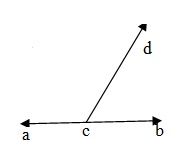
∴ ∠ACD + ∠BCD = 180°.
---The sum of all angles formed on the same side of a line at a given point on the line is 180°. In the given figure four angles are formed on the same side of AOB.
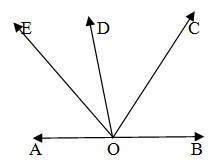
∴ ∠AOE + ∠EOD + ∠DOC + ∠COD = 180°.
---The sum of all angles around a point is 360° In the given figure five angles are formed around a point O.
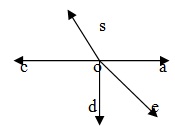
∴∠AOB + ∠BOC + ∠COD + ∠DOE + ∠EOA=360°
5. Parallel lines:
If two lines lie in the same plane and do not intersect when produced on either side then such lines are said to be paralleled and we write, L||m.
---Traversal line cutting parallel lines
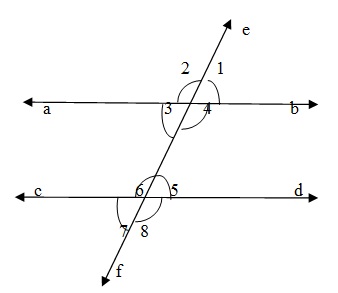
Let two parallel lines AB and CD be cut by a transversal EF. Then
Corresponding angle are equal
(∠1 = ∠5), (∠4= ∠8 ), (∠2 = ∠6) , (∠3 = ∠7)
Alternate interior angles are equal.
(∠3 =∠5 ) and (∠4 =∠6 )
Consecutive interior angles are supplementary
∠4+∠5 = 180° and ∠3 +∠6 = 180
6. Triangle:
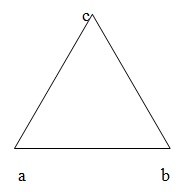
A figure bounded by three straight lines is called a triangle. In the given figure, we have ∆ABC; ∆ABC having three vertices A, B, C. In has three angles, namely ∠A,∠B, and ∠C. It has three sides, namely AB, AC, and BC.
- Types of Triangle
A triangle having all sides equal is called an equilateral triangle.
A triangle having two sides equal is called an isosceles triangle.
A triangle having all sides of different lengths is called a scalene triangle.
A triangle one of whose angles measures 90°, is called a right triangle.
A triangle one of whose angle lies between 90° and 180° is called an obtuse triangle.
A triangle each of whose angles is acute is called an acute triangle.
The sum of all sides of a triangle is called the perimeter of the triangle.
The sum of two sides of a triangle is greater than the third side.
In a right-angled ABC in which ∠B = 90°, we have AC2 =AB2+BC2. This is called Pythagoras Theorem.
7.Quadrilateral:
A figure bounded by four straight lines is called a quadrilateral. The sum of all angles of a quadrilateral is 360°.
- Rectangle - A quadrilateral is called a rectangle if its opposite side is equal and each of its angles is 90°. In given fig. ABCD is a rectangle.
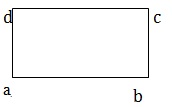
- Square - A quadrilateral is called a square if all of its sides are equal and each of its angles measures 90°. In given fig. ABCD is square in which AB = BC = CD = DA.

- Parallelogram - A quadrilateral is called a parallelogram if its opposite sides are parallel. In given fig. ABCD is a parallelogram in which AB = DC & AD = BC.
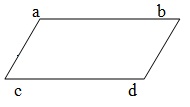
- Rhombus - A parallelogram having all sides equal is called a rhombus. In given fig. ABCD is a rhombus in which AB =BC =CD=DA, AB || DC and AD || BC.
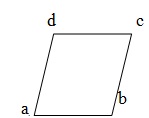
Important Facts
A quadrilateral is a rectangle if opposite sides are equal and its diagonals are equal.
A quadrilateral is a Square if all sides are equal and the diagonal are equal.
A quadrilateral is a parallelogram if opposite sides are equal.
A quadrilateral is a parallelogram but not a rectangle if opposite sides are equal but the diagonals are not equal.
A quadrilateral is a rhombus but not a square if all their sides are equal and the diagonals are not equal.
8. Circle:
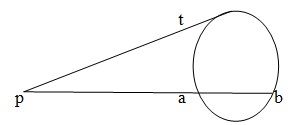
The perpendicular from the center to a chord bisects the chord.
There is one and only one circle passing through three non-collinear points.
The angle in a semi-circle is a right angle.
Opposite angles of a cyclic quadrilateral are supplementary.
Angle in the same segment of a circle is equal.
The tangent at any point of a circle is perpendicular to the radius through the point of contact.
Two tangents to a circle from a point outside it are equal.
If PT is a tangent to a circle and PAB is a secant, Then PA x PB= PT2
Comments
Post a Comment